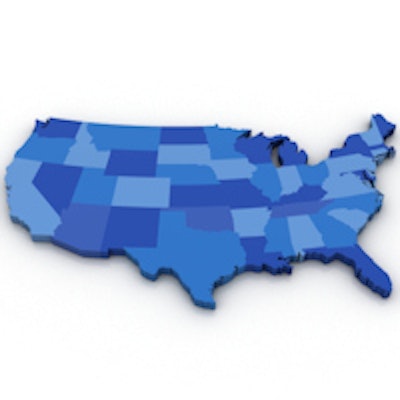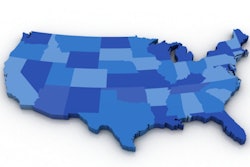
Newly available data from the U.S. Centers for Medicare and Medicaid Services (CMS) show that wide variations in the use of brain CT and lumbar MR imaging exist across the U.S., according to a study published online in Radiology. The findings could help policymakers tailor interventions to curb overuse among providers.
"We identified potential geographic and procedure targets for improving providers' use of diagnostic CT and MR imaging," wrote lead author Dr. Ivan Ip and colleagues from Brigham and Women's Hospital. "Policymakers should consider the potential for more targeted interventions, which may be more cost-efficient than 'one-size-fits-all' national campaigns to reduce waste and improve quality in medical imaging."
Previous research on regional imaging variation has focused on the use of imaging in beneficiaries living in a particular region, regardless of where the imaging services were actually performed, the authors wrote. However, because interventions to optimize imaging use often focus on providers, the researchers sought to identify regional variation in imaging use by provider in hopes of identifying potential targets for performance improvement initiatives (Radiology, February 5, 2015).
 Dr. Ivan Ip from Brigham and Women's Hospital.
Dr. Ivan Ip from Brigham and Women's Hospital.Ip's team used a newly available public database from CMS, gleaning 2012 physician payment data to examine geographic variation in providers' use of diagnostic imaging, specifically CT and MR. The database included beneficiary and service counts, provider charges, Medicare-allowed amounts and payments, place of service, and provider type, as well as some provider demographics.
That year, a total of 124 million unique diagnostic imaging exams, costing $5.6 billion in Medicare payments, were performed for 34 million Medicare beneficiaries across 306 hospital referral regions (HRRs), according to the authors.
Ip and colleagues controlled for patient referral patterns across regional healthcare markets based on tertiary care referral patterns, or HRRs, by using an imaging referral index (IRI) for each region. IRIs were calculated by dividing the number of overall imaging studies performed in a particular region by the number of overall imaging studies performed for Medicare beneficiaries living in that same area.
"We realized that for imaging, there's a higher likelihood of people crossing HRR boundaries," Ip told AuntMinnie.com. "This boundary-crossing phenomenon is often neglected, so that's why we wanted to perform the study."
Regions with an imaging referral index greater than 1 performed more studies than the local population received -- thus acting as "importers" of Medicare beneficiaries receiving imaging services. Regions with an IRI of less than 1 were "exporters" of Medicare patients receiving imaging services.
Studies have suggested that 81% of Medicare expenditures occur in the HRR in which beneficiaries live. But Ip's group found that most patients were undergoing imaging at centers outside of their immediate region -- particularly in areas of the U.S. with large referral centers (such as the Mayo Clinic in Rochester, MN, for example, which performs more than twice as many imaging studies than local facilities). In fact, imaging referral index numbers varied more than 10-fold, from 0.25 in Greeley, CO, to 2.4 in Rochester.
Higher IRI rates do not necessarily mean imaging is being overused, Ip said. He and his colleagues developed the IRI framework to correct for variations in imaging use due to referral centers located in particular areas.
"The raw numbers show high imaging utilization in big referral centers such as Rochester," he said. "But that doesn't necessarily mean there's anything wrong."
Intensity and cost of imaging use
The group also measured imaging use "intensity" and found that for CT, the average unadjusted use intensity ranged from 226.8 studies per 1,000 beneficiaries in the lowest geographical area to 792.1 per 1,000 beneficiaries in the highest. After adjusting for IRI, the use intensity range narrowed to 330.4 studies per 1,000 beneficiaries in the lowest area and 684 per 1,000 beneficiaries in the highest.
For MR, the average unadjusted use intensity ranged from 75.6 studies per 1,000 beneficiaries in the lowest area to 286.6 per 1,000 beneficiaries in the highest. After adjusting for IRI, the use intensity range shifted to 105.7 studies per 1,000 beneficiaries in the lowest area and 256.3 per 1,000 beneficiaries in the highest.
As for Medicare payments, the average payment for CT ranged from $437,120 in the lowest hospital referral region in 2012 to $1.4 million in the highest; average MR payments that year ranged from $268,375 to $14.2 million.
High-impact HRRs for both adjusted intensity and payment consisted of two areas for CT -- Jacksonville, FL, and Baltimore -- and 11 for MR: Fort Myers, Fort Lauderdale, Orlando, and Jacksonville, FL; Dallas; Palm Springs-Rancho Mirage, CA; Las Vegas; Washington, DC; New Brunswick, NJ; East Long Island, NY; and Phoenix.
The most common CT and MR exams were head and/or brain CT, at 158 studies per 1,000 Medicare beneficiaries, and lumbar spine MR, at 43 exams per 1,000 Medicare beneficiaries.
What do the results indicate? Tailored imaging interventions targeted to regions where overuse is occurring could work better than ones designed at the national level, according to Ip and colleagues. These interventions could include grand rounds lectures or other educational materials, as well as health IT approaches.
"At Brigham and Women's, we've incorporated clinical decision support into our computerized order-entry system, and we've seen a 30% decrease in unnecessary MR use," Ip told AuntMinnie.com. "There are multiple overuse intervention approaches, and the best one is what works locally."





















